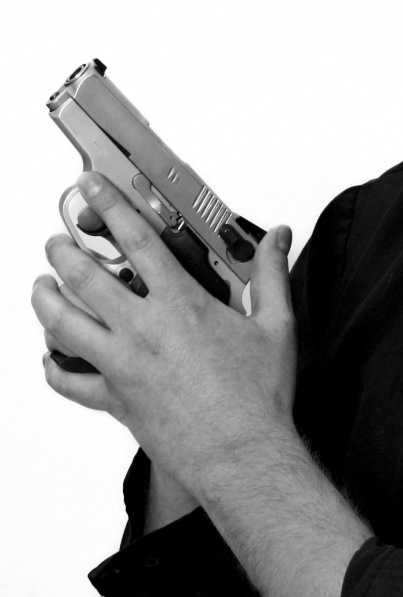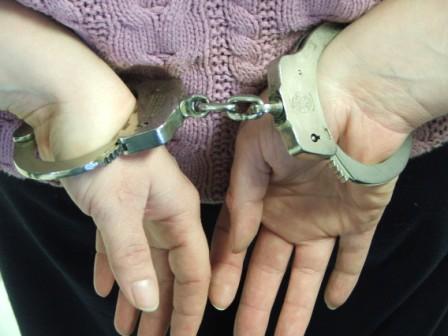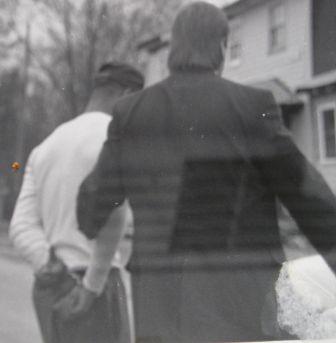Stop and Frisk has once again worked its way into the news by way of politics, with a former presidential candidate apologizing for the use of the practice in a city where he once served as mayor. Those stops, he once vehemently argued, were necessary to help curtail the city’s out of control gun violence.
Since I choose to not dip my toes into political waters, opting only to present factual information which is often on the opposite end of the political truth meter, let’s instead examine “stop and frisk” and the Supreme Court decision that supports its use. We’ll also have a look at why, when properly utilized, its an effective tool.
What is Stop and Frisk?
Here’s how it all began, and it’s not a newfangled practice, not by any means.
In the mid 1960s, when I was still not quite a teenager (yes, this law has been on the books for a long, long time), a Cleveland, Ohio detective named McFadden saw two men, strangers to the area, walking back and forth in front of a store. On each pass the men stopped to look into the store window. McFadden watched the men while they made a dozen or so trips past the storefront. After each trip by the business the two men met at the street corner to chat for a minute or two. Soon, a third man joined the pair at the corner.
Detective McFadden, being quite the observant and proactive officer, had seen enough to send his “cop radar” into overdrive. He was certain the men were “casing” the place, waiting for just the right moment to rob the store owner. Their mannerisms, as do many telltale gestures of criminal behavior, telegraphed their intentions.
McFadden approached the three men, identified himself as a police officer, and then asked for their names. Someone mumbled something but no names were offered. Sensing things could quickly go downhill, McFadden grabbed and spun around one of the mumblers(John W. Terry) and patted the outside of his clothing, feeling a pistol in the man’s coat pocket.
Unable to retrieve the pistol on the street while keeping an eye on all three potential robbers, the detective ordered the men inside the store where he had them face the wall with their hands in the air. McFadden retrieved the pistol from the first suspect’s coat and then patted the clothing of the the other two men. During the searches McFadden located a second pistol. As a result, the three men were detained and taken to the police station. The two men with the guns were charged with possession of a concealed weapon.
On appeal, Terry argued that the officer had violated their constitutional rights according to the 4th amendment (unlawful search and seizure). However, the U.S. Supreme Court ruled in favor of the officer, stating that his search was the minimum action required to see if the men were armed, a necessary tactic to safeguard his safety and the safety of others. And, that the suspects were indeed acting in a manner consistent with the probability of robbing the store owner.

Basically, the Court did not change or add laws to the books. Instead, they upheld that whenever possible and practicable, a police officer must obtain a warrant to conduct a search and seizure. However, they ruled, an exception must be made when “swift action” is required based on the observations of an officer.
Detective McFadden’s stop and frisk tactic has since been known as a Terry Stop. It’s a proactive tactic that prevents some crime before it happens, and it helps reduce the numbers of illegal weapons often carried by criminals. Without Terry Stops (Stop and Frisks), bad guys have no fear of being caught carrying a gun.
The Terry Stop According to the Supreme Court ruling Terry v. Ohio
A Terry stop is defined as a brief, temporary involuntary detention of a person suspected of being involved in criminal activity for the purpose of investigating the potential criminal violation.
In order to lawfully conduct a Terry stop, a law enforcement officer must have “reasonable suspicion,” which has been defined as “articulable facts (articulable means able to explain in words) that would lead a reasonable officer to conclude that criminal activity is afoot—more than an unsupported hunch but less than probable cause and even less than a preponderance of the evidence.
A police officer may, in appropriate circumstances and in an appropriate manner, approach a person for the purpose of investigating possible criminal behavior even though there is no probable cause to make an arrest.
Also known as the Common Law Right of Inquiry, this section of existing law permits an officer or agent to engage any citizen in a purely voluntary conversation (i.e. “May I speak with you a moment? Do you need any help? How long have you been here?”). In these cases, a citizen must be free to terminate the conversation at any time and go his or her way with no restrictions. This, however, is not a Terry Stop where an officer would conduct a pat-down of the person(s). Remember, this is a voluntary action on the part of the citizen. Terry Stops are not voluntary. In fact, Terry Stops are brief periods of actual detention that may include handcuffing the detained subject for the safety of the officer and others.
*The preceding three paragraphs are excerpted, with some paraphrasing, from FLETC training material. FLETC is the Federal Law Enforcement Training Centers.
Based upon Terry v. Ohio, what are officers permitted to do regarding pat-down searches?
Officers may, even without sufficient cause for arrest, briefly detain someone if …
- the officer identifies him/herself as a police officer (either by the uniform and badge, or verbally) and asks reasonable questions regarding the suspect’s current conduct.
- the officer has knowledge of facts that lead them to believe the suspect is involved in some sort of illegal activity.
- the person they’ve stopped does not immediately justify his actions in a manner that satisfies the officer’s suspicions.
Officer’s may conduct a pat-down search during a Terry Stop if they have a reasonable suspicion, based on personal knowledge of facts, that the person is armed.
The Terry Stop is a Search for Weapons
Officers may not, however, go out on “fishing expeditions” under the guise of the Terry Stop. There must be facts supporting their reasons for a “frisk.”
By the way, a pat-down search is exactly as it sounds. Officers may only “pat” the outer surfaces of clothing. They may not reach into a person’s pockets unless they feel a weapon.
There is an exception to the rule, however, and that’s when an officer who has sufficient training and first-hand knowledge of narcotics packaging, “feels” what he/she suspects is a packet of drugs.
The skilled officer, one who’s extremely familiar with narcotics and how the various ways they’re wrapped and contained, may then reach into the pocket to retrieve the packet. To do so, the officer must be able to testify under oath, and verify, that he/she has the sufficient experience and training that would give them the knowledge needed to identify narcotics packaging by feel.
An example would be an officer who worked undercover or on a narcotics task force, like me. I was deemed an expert witness by the courts and, as an expert, was often called upon to testify in various cases.
If an officer’s assignment is to patrol a high crime area of the city, then it should be no problem to spot people who’re engaging in suspicious activity—drug dealers, robbers, rapists, car thieves, etc.
Those are the people, the folks involved in some sort of criminal activity, who warrant being stopped and frisked, if they exhibit signs of criminal intent. Not mom and pop and baby brother who’re on their way to church, school, or the grocery store. And certainly it is not permissible or even ethical to stop someone for a pat-down merely because their skin is a certain color.
When used properly, Terry Stops/Stop and Frisks are a highly effective means of removing weapons and illegal narcotics from the street. When crooks know officers may approach and search they’re more apt to leave their guns at home or at least keep them hidden, out of their pockets. And, without having a firearm instantly available, the tendency to shoot first and ask questions later is greatly reduced.
Remember, Stop and Frisk/Terry Stops are still absolutely legal and constitutional, and they’re done each and every day all across the country. This, as current law states, is not debatable. Department policy, however, may differ.

Still, Terry Stops (Stop and Frisk) are absolutely legal and I can say that without a doubt these stops are an essential part of both proactive and reactive policing, and they save lives. At the very least, the practice helps remove illegal guns from the hands of those who’re likely to injure or kill others.
You’re the Officer
If you, as a police officer, saw an agitated, nervous and sweaty person wearing a long overcoat in the middle of July, a coat with a distinctive bulge on the right side in the shape of a shotgun, who was about to enter a school, church, Walmart, sports stadium, or other location, what would you do?
Shouldn’t you be able to act based upon the coat and the mysterious gun-shaped object beneath it, along with the person’s odd appearance and actions? Wouldn’t you want to stop that person and pat them down as a precaution BEFORE he has the chance to encounter the people inside those venues? After all, your suspicions as a trained and experienced officer are reasonable, right?
Suppose you didn’t check them for weapons and they went inside and began shooting innocent people?
What if you had reasonable suspicion that a person was about to enter a school with a firearm? Would you allow them to go inside without first conducting a lawful Terry Stop/Frisk? A quick pat down to check for weapons and then send them on their way would be appropriate, correct?
So why tie the hands of officers? How many victims could/would be spared the horror and trauma of violence associated with gunfire that’s intended to do harm had police been permitted to do their jobs?

*Please do not turn this article into a political discussion. It is meant as a learning tool about Stop and Frisk. Nothing more. Again, PLEASE keep politics as far away from this site as possible. I treat it like the plague. I only mentioned the politician above because they brought this topic to the attention of the media.
Politics … BAH, HUMBUG!
Friday Shopping With a Cop

Need help with the legal aspects of search and seizure? Is the hero of your tale on the fence about whether it’s okay to search?
How do you interpret a person’s behavior during their interview?
Kindle Unlimited!
Kindle Unlimited Membership Plans
What if you could see in the dark? Well now you can with this night-vision monocular!
Lightweight binoculars that are perfect for surveillance and even for watching your favorite backyard birds.
Uniden scanner – Listen in on police, fire, EMS, and even air traffic, and in-progress weather information.
Your very own Breathalyzer!
From J.D. Robb
It’s dress-up time for the kids!
Hero’s Valor St. Michael Patron Saint of Law Enforcement Challenge Coin
Lightweight adjustable tactical belt




